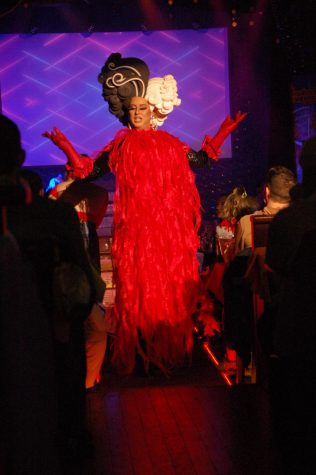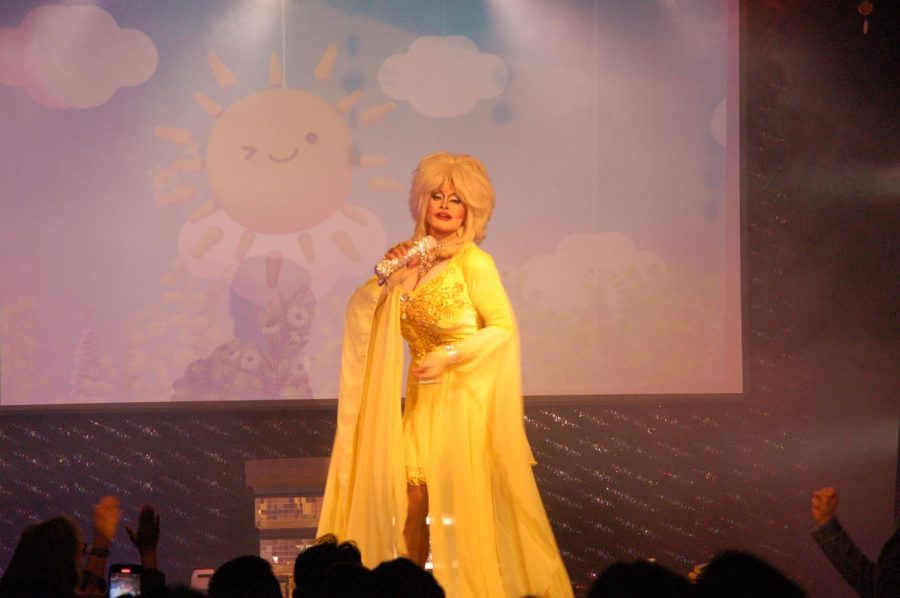Drag Is Not Just for the Adults
From behind a shimmering silver curtain, the Wicked Queen steps out. No, not the murderous villain from “Snow White.” Think more… dazzling bodysuit, wild purple hair, and a diamond-studded tiara. Drag performer Diamond St. James turns from the magic mirror to strut down the aisle, lip-syncing to ’80s throwbacks — offering a fiery show to an entranced audience of millennials and, as it happens, two high schoolers (us!). Eating a plate of waffles and scrambled eggs — a classic Saturday afternoon meal — we continued to watch as the spectacle unfolded in Julia’s on Broadway, a theater in Seattle’s Capitol Hill neighborhood. That was just one act of the throwback drag brunch at Julia’s on Broadway, which also included the likes of Catwoman swinging a gyrating metal platform, ABBA performing their greatest hits and dancing in sync, Shrek and Donkey twerking, and, of course, the obligatory Dolly Parton impression. While we came to Julia’s to watch these jaw-dropping acts, we also had the chance to speak to four of the drag performers about their experiences and thoughts on the importance of drag.
Drag as an art form has a long and complicated history leading up to the present moment. In ancient Greece and Victorian England, men would play female theater roles when women weren’t allowed to perform onstage themselves. Toward the beginning of the 20th century, drag became tied to the LGBTQ+ community, and queens and kings would perform in underground nightclubs as “cross-dressing” and queerness were criminalized. Drag performers, especially performers of color, played pivotal roles in gay liberation riots in the late 1960s.
Now, drag has been thrust into the spotlight of culture wars. Drag events have been targeted by Republican politicians and right-wing groups, who say they’re overly sexual and dangerous to children. Bills that would restrict where drag events can be held and who can attend them are making their way through legislatures in at least 16 states.
Most of these bills ban drag or “adult cabaret” performances in public or in the presence of minors, and some include thousand-dollar fines for violations or jail time for repeat offenders. These bills fit into a wider legislative pattern in Republican-controlled states of backlash against the increased acceptance of transgender and non-binary people. For example, many communities have also banned teaching about trans identities or reading books with trans characters in schools.

Attacks on drag aren’t limited to other states: Washington has faced attacks as well, some of which have escalated to violence. In December 2022, the window at a taproom in Renton was shot through with a B. B. gun after a conservative Facebook group called for a protest against the drag queen story hour they were hosting. Recently, on April 9, a Thai restaurant in Richland that hosted an all-ages drag brunch was vandalized and sent a threatening letter addressed from “AR-15 Die St.”
A common argument against drag performances is the notion that all drag is explicit and thus too mature for children. Yet Shay Fox, a queen at Julia’s Saturday brunch, stresses that drag performers are simply entertainers, and that “as entertainers we’re able to flex and be versatile with our art form.” For example, she used to host an all-ages show and would adjust the content of her performances, music, and language (mainly refraining from saying “b*tch”) to match that audience. Saying that all drag is overly sexual is like saying that all comedy is overly sexual — yes, comedy can be sexual, but it is not inherent to the genre. The Saturday drag brunch we attended had its fair share of crude humor but little sexual content. Ultimately, individual parents should be able to decide if their kids can see particular drag shows, not the state.
The performers at Julia’s emphasize that letting everyone, including children, see drag shows if they’re interested is extremely valuable. Speaking about restrictions on drag shows, performer Sean Paul compares them to school: “You’re either gonna teach it the correct way in class, or you can teach it the wrong way at home. So why not expose them to drag the correct way… rather than somewhere down an alley?” In this way, rather than being dangerous, established drag events and productions are some of the safest places for people to find out about drag.
As a form of entertainment, drag reflects a wide range of sexual and gender identities. Some performers, such as Sean Paul, consider themselves celebrity impersonators instead of drag queens. “I’m completely all man,” he says. “I’ve never had any desire to become a woman.” But for others, drag is a forum to explore gender outside of the male/female binary. Drag queen Versace Doll tells the story of being introduced to drag and using it as a “bridge” to explore her gender identity and establish herself as a transgender woman. Diamond makes clear that drag is not limited to queer folk dressing as a different gender: straight, gay, cisgender, or genderqueer, drag is simply a form of self-expression.
Often considered an adult form of entertainment, drag has been made inaccessible to children because of the assumptions of oversexualization and obscenity that cloud its true intentions of self expression. We feel incredibly lucky to have been able to attend this show. As teenagers, it can be difficult to find a drag event to go to: we’re too young for burlesque shows but possibly too old for a story hour — although can you ever outgrow story hours?
But Seattle’s drag scene, especially on Capitol Hill, is lively and flourishing. Through a quick Google search or a couple of emails, anyone can find events to attend, including many in restaurants across the greater Puget Sound area. For those looking for suggestions, check out seattlepride.org for information about events all through June (Pride Month), ranging from concerts, to the annual Pride parade, to festivals in Volunteer Park, many of which are casual atmospheres to learn about drag.
An interest in learning more about drag is key. Anti-drag ideas and legislation are spreading like wildfire because many Americans don’t have accurate perceptions of drag. Education is vital to changing these misconceptions. To start, anyone interested can conduct their own research online, watch documentaries like Paris is Burning, or follow shows like RuPaul’s Drag Race. Students interested in the history surrounding drag and LGBTQ+ rights can also take Lakeside’s Queer U. S. History elective.
While the national political landscape surrounding drag and trans rights looks bleak, the performers at Julia’s remain hopeful for the future, especially because of the change that Gen Z has brought. “Your guys’ era has changed our lives,” says Versace Doll. In the past, “you didn’t have he, she, they. It was just him or her; that was it. But you guys have come in and changed that.” With the increased visibility of trans and gender-nonconforming people, everyone can better express their true selves and find much-needed role models.
While often demonized and misrepresented, drag at its essence boils down to a method of expression and entertainment. It’s valuable for performers and attendees and fun for everyone involved. Anyone who has the opportunity to see a drag performance should take it — and support the local drag community in the process. It’s a bonus if there are waffles involved.
Review: Lucy: The Movie (★★★★☆)
Released in 2006, Lucy was an instant classic the day she hit movie theaters. The movie’s character development...
Review: Zane: The Movie (★★★★☆)
Released in early 2006, Zane quickly became a fan favorite. A charming and lovable fella, Zane has captured...

